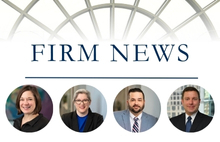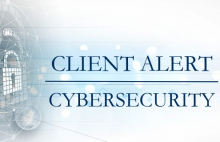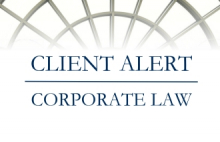Department of Labor Guidance on Families First Coronavirus Response Act: Employer Takeaways Part Two
April 6, 2020The discussion that follows is a continuation of our analysis of key interpretive guidance from the Department of Labor (“DOL”) on the Families First Coronavirus Response Act (the “Act”). Our first installment, Employer Takeaways Part One, was last updated on April 3, 2020.
Employee Documentation for Illness-related Leave: Confirmed
Employees seeking Paid Sick Leave and Emergency Family Leave must submit documentation to their employers. The DOL’s Temporary Regulations provide that an employee seeking leave must provide documentation of the following: (1) the employee’s name; (2) the date(s) for which leave is requested; (3) the COVID-19 qualifying reason for leave; and (4) an oral or written statement representing that he or she is unable to work or telework because of the COVID-19 qualifying reason.
An employee is required to provide additional documentation depending on the COVID-19 qualifying reason for leave. For example, if an employee is requesting Paid Sick Leave due to a government quarantine or isolation order, then the employee must provide the name of the government entity that issued the order. If an employee is requesting Paid Sick Leave because a health care provider advised him or her to self-quarantine, then the employee must provide the name of the healthcare provider. If an employee is requesting Paid Sick Leave to care for an individual subject to a quarantine order, then the employee must provide either (1) the government entity that issued the quarantine or isolation order to which the particular individual is subject or (2) the name of the health care provider who advised the individual to self-quarantine, depending on the precise reason for the request.
Surprisingly, at least at this point, there is no provision allowing an employer to obtain a doctor’s note, although it is difficult to imagine the DOL (or EEOC, to the extent such a request would constitute a disability-related inquiry under the ADA) penalizing an employer for making such a request.
Employee Documentation for Childcare: Expanded
Likewise, if an employee is requesting Paid Sick Leave or Emergency Family Leave to care for his or her son or daughter because of a school or child care closure, the DOL’s Temporary Regulations require the employee to provide the following information: (1) the name of the child being cared for; (2) the name of the school, place of care, or child care provider that closed or became unavailable due to COVID-19 reasons; and (3) a statement representing that no other suitable person is available to care for the child during the period of requested leave. The DOL also set forth that an employer may request other documentation the IRS requires in order to support the employer’s request for tax credits under the Act.
In exercising its authority to oversee the tax credit component of the Act, the IRS added a fourth requirement. When an employee claims he or she is unable to work or telework because of a need to provide care to a child over the age of 14 during daylight hours, the employee must provide a statement that special circumstances exist that require the employee to provide care for that child.
The requirement that no other suitable person is able to care for the child may assist employers striving to avoid abuse of the paid leave benefit. The IRS’s heightened standard for 14 to 18-year-olds further strengthens that protection against abuse. The IRS’s guidance can be found here.
Note: Employers are required to retain all leave-related documentation for four years, regardless of whether the leave was granted or denied. In cases where an employee provided an oral statement to support a request for leave under the Act, the employer is required to document such oral statement in writing and retain it as if the employee had submitted a written statement or request.
Employees Not Entitled to Leave When Work is Unavailable: Confirmed
At several points in the Temporary Regulations, the DOL emphasizes that the new paid leave is not available when the employer does not have work for the employee. This rule appears to refer to instances in which the employer is either shut down or where the employee is on a furlough and not permitted to work. The employee may, of course, seek unemployment benefits (now enhanced by the CARES Act) for the period of time in which there is no work.
Similarly, employees who retain their jobs but experience a reduction in hours are not permitted to take leave for any hours they are no longer scheduled to work. However, an employee can take Paid Sick Leave or Emergency Family Leave if a qualifying reason prevents them from working his or her full schedule.
Health Care Providers Excluded from Benefits: Expanded
Employers may exclude “health care provider” employees from the Act’s Paid Sick Leave and Emergency Family Leave benefits. Since “health care provider” is a defined term in the existing FMLA, and is used in this same context elsewhere in the Act, it was expected that the same or analogous definition would apply to the exclusion. The Temporary Regulations substantially broaden the definition for exclusion purposes. Employers can now exclude the following persons from leave under the Act:
anyone employed at any doctor’s office, hospital, health care center, clinic, post-secondary educational institution offering health care instruction, medical school, local health department or agency, nursing facility, retirement facility, nursing home, home health care provider, any facility that performs laboratory or medical testing, pharmacy, or any similar institution, employer, or entity. This includes any permanent or temporary institution, facility, location, or site where medical services are provided that are similar to such institutions.
This definition includes any individual employed by an entity that contracts with any of the above institutions, employers, or entities institutions to provide services or to maintain the operation of the facility. This also includes anyone employed by any entity that provides medical services, produces medical products, or is otherwise involved in the making of COVID-19 related medical equipment, tests, drugs, vaccines, diagnostic vehicles, or treatments. This also includes any individual that the highest official of a state or territory, including the District of Columbia, determines is a health care provider necessary for that state’s or territory’s or the District of Columbia’s response to COVID-19.
Under this rather sweeping definition, seemingly any employee who works in the health care industry could be excluded.
Intermittent Leave: Restricted
Many questions have been raised as to whether an employee may take intermittent Paid Sick Leave or Emergency Family Leave. The answer is yes, but only if the employer agrees and the circumstances permit. Unlike most intermittent leave under the pre-Act FMLA, employers are free to deny intermittent use of the new paid leave benefits if their business needs dictate otherwise.
Generally, if an employee is teleworking, but is unable to work normal hours due to a qualifying reason under the Act, an employer may agree to permit the employee to take intermittent leave. This includes partial day leave where an agreement can be made. However, employees who continue to work onsite are more restricted in their ability to take intermittent leave. Under the Temporary Regulations, once a non-teleworking employee begins taking Paid Sick Leave, the employee must continue taking Paid Sick Leave each day (in full day increments) until the employee uses the full amount of Paid Sick Leave or no longer has a qualifying reason to take Paid Sick Leave. This limit is apparently imposed with a goal of keeping employees on leave away from work and minimize spread of the virus to others. The single exception to this rule is when Paid Sick Leave is taken for childcare reasons. Under these circumstances, an employer may agree to permit the employee to take Paid Sick Leave (or Emergency Family Leave) on certain days of the week when childcare is unavailable and work the other days of the week when childcare is available.
Supplementing FFCRA Leave Benefits with Existing Company Leave Benefits: Permitted
In order to avoid a reduced paycheck associated with leave to care for another (2/3 pay up to $200 per day), many employees may seek to supplement the pay differential with existing company leave benefits. Such substitution is permitted, but certain restrictions apply. With respect to the first two weeks of unpaid Emergency Family Leave, an employee cannot simultaneously take Paid Sick Leave and existing company paid leave, unless the employer agrees. After the first two weeks of Emergency Family Leave (which may be unpaid if the employee does not have Paid Sick Leave available), the employee may elect to supplement his or her remaining Emergency Family Leave benefits with any paid leave offered under the employer’s existing leave policy.
With respect to Paid Sick Leave benefits, an employer may not require an employee to use his or her existing employer-provided leave benefits before using Paid Sick Leave. An employer also cannot require an employee to use Paid Sick Leave concurrently with his or her existing company leave benefits. However, if the employer agrees, an employee may use existing company leave benefits to supplement the amount he or she received from Paid Sick Leave up to the employee’s normal earnings.
Although the Temporary Regulations are somewhat contradictory on this point, on April 3, 2020 the DOL revised its Q&A No. 33 to permit employers to require that employees take employer-provided leave concurrently with the paid leave under the Act. In that case, employees would receive their full pay, with 2/3 coming from the Act’s paid leave requirement and 1/3 coming from the employer-provided leave.
Note: An employer is only entitled to receive a tax credit for the amount of Paid Sick Leave that the employer is required by the Act to pay.
Leave Under All FMLA Limited to 12 Weeks in 12-month Period: Confirmed
There has been some uncertainty as to how an employee’s Emergency Family Leave may affect the amount of time off he or she may be entitled to under the FMLA. The DOL has clarified that employees are still limited to taking 12 workweeks of leave during a 12-month period determined by their employer, whether the leave qualifies as regular FMLA leave or Emergency Family Leave under the Act. Therefore, if an employee already used FMLA leave during the same 12-month period during which he or she also qualifies for Emergency Family Leave, his or her amount of eligible Emergency Family Leave would be reduced by the time he or she had previously been out on FMLA.
Note: Employees are entitled to two weeks of Paid Sick Leave regardless of how much Emergency Family Leave or FMLA leave has been taken.
What’s Next?
At this time, the DOL has advised that its April 1, 2020 regulations are temporary in nature, which means that the guidance could change yet again in the near future. Indeed, the agency is regularly updating and expanding its Q&A page. Although we do not anticipate that there will be major changes in the guidance already published, we will continue to monitor all developments as they occur and publish additional guidance, including the companion to this Alert – Takeaways for Employers Part One – as necessary.
Please feel free to reach out to a Lewis Rice labor and employment attorney with any questions or concerns.








